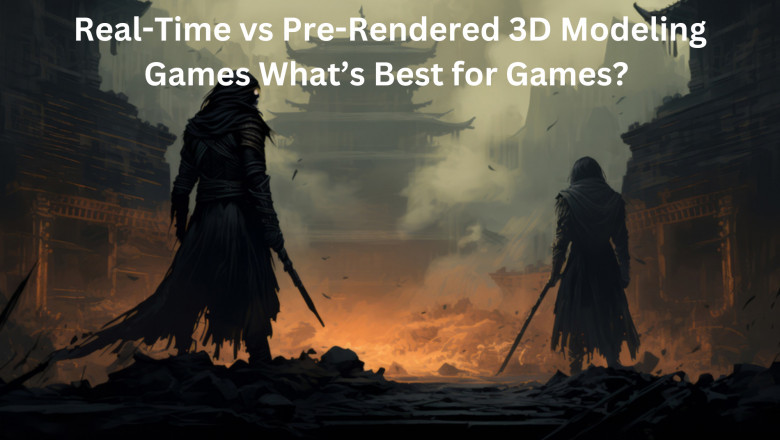views
3D modeling is a critical aspect of game development, influencing performance, aesthetics, and player experience. When it comes to game graphics, developers must decide between real-time rendering and pre-rendered graphics. Both approaches have their unique advantages, but which one is best for your game? In this article, we'll explore the key differences, pros and cons, and how each impacts 3D modeling games, 3D game assets, and 3D game environment.
Understanding Real-Time and Pre-Rendered 3D Modeling
Before diving into the comparison, let’s define the two methods:
What is Real-Time 3D Modeling?
Real-time 3D modeling refers to graphics that are rendered instantly as the player interacts with the game. These graphics are processed by the game engine and graphics card in real-time, making them ideal for interactive experiences.
What is Pre-Rendered 3D Modeling?
Pre-rendered 3D modeling involves rendering graphics beforehand and displaying them as static or pre-computed visuals. This approach is common in cutscenes, cinematics, and games where high-fidelity visuals are prioritized over real-time interaction.
Key Differences Between Real-Time and Pre-Rendered 3D Modeling
Real-Time Rendering in 3D Modeling Games
Advantages of Real-Time Rendering
-
Seamless Interactivity: Games that require constant player input, such as first-person shooters or open-world RPGs, rely on real-time rendering to create immersive experiences.
-
Optimization for Hardware: Real-time rendering is designed to balance performance and quality, ensuring smooth gameplay across various hardware configurations.
-
Dynamic Environments: In 3D game environments, real-time rendering allows for interactive elements, such as destructible objects, dynamic weather, and NPCs that react to the player.
Challenges of Real-Time Rendering
-
Hardware Limitations: The quality of 3D game assets depends on the capabilities of the player's device. Older hardware may struggle to maintain high frame rates with complex 3D environment modeling.
-
Optimization Required: Developers must optimize 3D hard surface modeling, textures, and lighting to prevent performance drops.
Best Use Cases
-
Open-world games (e.g., Grand Theft Auto, The Witcher)
-
Multiplayer games (e.g., Fortnite, Call of Duty)
-
VR and AR applications
Pre-Rendered 3D Modeling in Games
Advantages of Pre-Rendered Graphics
-
Unmatched Visual Fidelity: Pre-rendered cutscenes can feature high-poly 3D game assets, cinematic lighting, and detailed textures that real-time engines can’t achieve.
-
No Performance Restrictions: Since rendering occurs before the game is played, developers can push 3D environment modeling to photorealistic levels without impacting gameplay performance.
-
Consistent Quality: Unlike real-time graphics, pre-rendered visuals remain high-quality across all devices, ensuring a polished experience.
Challenges of Pre-Rendered Graphics
-
Lack of Interactivity: Pre-rendered environments are static, making them unsuitable for dynamic gameplay.
-
Large File Sizes: High-quality props 3D models, car 3D models, and animations require substantial storage space.
Best Use Cases
-
Cinematic cutscenes (e.g., Final Fantasy, The Last of Us)
-
Strategy and story-driven games (e.g., Age of Empires, Telltale Games)
-
Mobile games with pre-rendered backgrounds
Which is Best for Your Game?
Choosing between real-time and pre-rendered 3D modeling games depends on the game's objectives, budget, and target audience.
Choose Real-Time Rendering If:
-
Your game requires 3D game environments that players can explore dynamically.
-
You prioritize gameplay over visual fidelity.
-
Your game needs to run smoothly on various hardware configurations.
Choose Pre-Rendered Rendering If:
-
Your game emphasizes storytelling and cinematic sequences.
-
You want to achieve ultra-realistic visuals without worrying about hardware limitations.
-
You are creating a linear game with minimal player interaction.
The Role of 3D Hard Surface Modeling and Vehicles
In both real-time and pre-rendered workflows, 3D hard surface modeling plays a crucial role in creating detailed environments, vehicles, and props. For example:
-
Car 3D models in racing games must be optimized for real-time performance.
-
3D vehicle modeling in flight simulators requires high levels of detail but needs to run efficiently.
-
Props 3D models, such as weapons and furniture, must balance detail with optimization to fit within performance constraints.
Conclusion
Both real-time and pre-rendered 3D modeling games have their advantages. Real-time rendering is essential for interactive gameplay and dynamic 3D game environments, while pre-rendered graphics offer superior visual fidelity for cutscenes and story-driven experiences. Understanding these differences will help game developers make informed decisions about their rendering approach and create the best possible gaming experience for their audience.






















Comments
0 comment